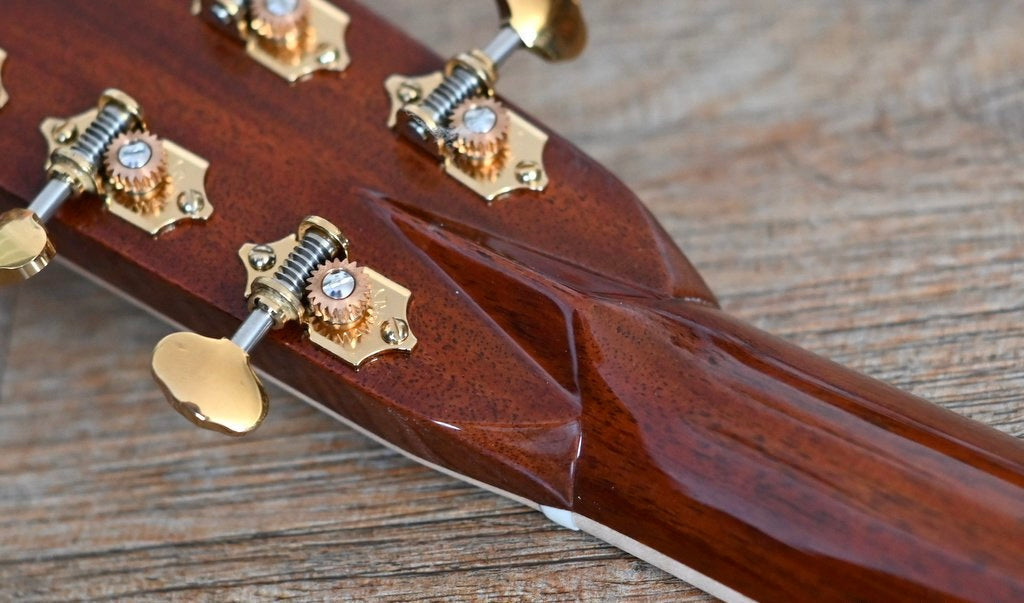
Open vs. Closed Tuners: What’s the Difference and Which Should You Choose?
Share
If you’ve ever shopped for guitar tuning machines or looked closely at the headstock of different guitars, you may have noticed that some tuners are “open” while others are “closed” or “sealed.” While they both serve the same purpose—keeping your strings in tune—there are key differences in design, performance, and aesthetics. Let’s break it down.
What Are Open Tuners?
Open tuners (also called open-gear tuners) are exactly what they sound like: the internal gear mechanism is visible. You can see the gear teeth and worm screw, typically on the back of the headstock.
Common on: Vintage-style acoustic guitars, many classical guitars, and some mandolins.

Martin D-28 (Reimagined model)
The 2017 Martin D-28 showcases vintage-style open gear tuners, reflecting the classic design that many guitar enthusiasts appreciate. These tuners are visible on the back of the headstock, adding to the guitar's traditional aesthetic.

Martin D-18 StreetLegend®
The Martin D-18 StreetLegend® features aged open-gear tuners, contributing to its vintage-inspired aesthetic. These tuners not only enhance the guitar's appearance but also offer reliable tuning stability.
Pros:
-
Vintage Aesthetic: Many guitarists love the old-school look of open tuners, especially on traditional or vintage-style instruments.
-
Easier Maintenance: Since the gears are exposed, it’s easy to clean and lubricate them.
-
Lighter Weight: Open tuners tend to be slightly lighter, which can make a small difference in balance and comfort.
Cons:
-
More Exposed: Dirt, dust, and moisture can get into the gears more easily, potentially affecting long-term durability if not maintained.
-
Less Common on Modern Guitars: You might not find them on high-performance or modern electric guitars, where more robust tuning stability is prioritized.
What Are Closed Tuners?
Closed tuners (or sealed tuners) encase the gear mechanism in a metal housing. The internal parts are protected from the outside environment and usually permanently lubricated.
Common on: Most modern electric guitars, steel-string acoustics, and bass guitars.
Pros:
-
Low Maintenance: The sealed design keeps the gears lubricated and protected, so you rarely have to worry about upkeep.
-
Durability: Less vulnerable to corrosion or environmental factors.
-
Smooth Operation: Generally designed for tighter tolerances, making them feel smoother and more precise.
Cons:
-
Heavier: The extra housing adds a bit of weight.
-
No Internal Access: If something goes wrong inside the housing, it’s difficult or impossible to repair—it usually means replacing the tuner.

Martin D-35
The Martin D-35 is equipped with chrome enclosed gear tuners, offering a sleek look and enhanced protection for the tuning mechanisms. These sealed tuners require less maintenance and provide smooth tuning action.
Which Should You Choose?
It depends on your guitar, your playing style, and your personal preference.
-
For vintage-style acoustics or restorations, open tuners might be the way to go. They look the part and are often lighter, which suits older headstocks.
-
For modern instruments or players who prioritize reliability and minimal maintenance, closed tuners are usually the better option.
-
For classical guitars, open tuners are traditional and most commonly used, though some modern variations may come with closed gear designs.
Final Thoughts
Both open and closed tuners have their place in the guitar world. Neither is inherently “better”—they just serve different needs. If you're replacing tuners or shopping for a new guitar, understanding the difference can help you make a choice that fits your playing habits, aesthetic preferences, and maintenance expectations.
